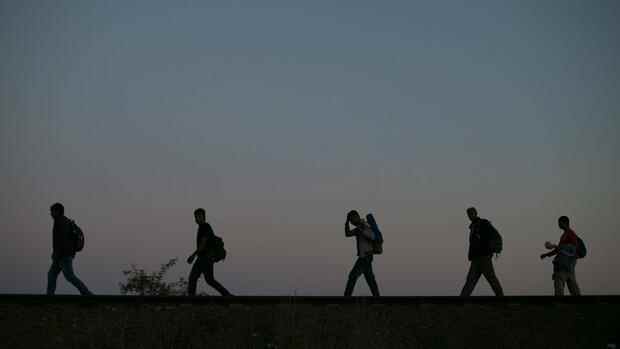Hungary has migratory pressures from the south and Ukraine.
(Photo: Imago/i Images)
Vienna The forests on the border between Hungary and Serbia are natural recreation areas. But for a few months now, dramatic scenes have been playing out in them. Scenes of a migration crisis, which is now rapidly gaining momentum again after a decline in immigration movements in the corona pandemic.
How dangerous the border region has become was last seen on Saturday morning: groups of people smugglers and migrants from Afghanistan and Pakistan exchanged gunfire for an hour. When the Serbian police arrived, they found one dead and six seriously injured, including a 16-year-old girl.
For Hungary, the incident shows that the threat posed by increasing migratory pressure in the south has reached a new level, as Foreign Minister Peter Szijjarto explained. “We Hungarians are basically the only ones challenged both from the south and from the east, we are under double pressure, so to speak,” he said at a meeting with his Serbian counterpart in the border town of Subotica on Monday.
The border guards have stopped more than 100,000 people at the fence so far this year, almost as many as in the entire previous year. There were 230 physical attacks on officials.
Top jobs of the day
Find the best jobs now and
be notified by email.
The Hungarian figures do not match those of the EU border protection agency Frontex, which, based on data from its member countries, recorded 40,000 illegal crossings along the entire Balkan route in the first five months of the current year. It is not clear where the discrepancy comes from.
Balkan route is not closed
Nevertheless, the data from Frontex also shows that the Balkan route is anything but closed. This manifests itself further west. Austria registered almost 22,000 asylum applications between January and May, two and a half times as many as in the same period of 2021. For the whole of last year, the country was in second place in the EU after Cyprus in terms of applications, converted to the population.
The numbers are all the more dramatic because they do not include the almost 74,000 Ukrainians who have fled to Austria since February and most of whom have received temporary protection status.
Their housing and employment poses major problems for the state, despite widespread solidarity among the population. Although Hungary has significantly higher numbers with more than 800,000 border crossings, according to the UN refugee agency UNHCR, only just under 26,000 people received protection there. Most traveled on after a short time.
The Ukrainians would be welcome in Hungary. In complete contrast to the migrants, most of whom come from the Middle East, who are holding out at the border with Serbia: Budapest sees them all as having entered illegally because they had crossed safe third countries.
An application for asylum cannot therefore be made at the border. The EU Commission believes that Hungary is not granting effective access to asylum procedures and has repeatedly taken the country to the European Court of Justice. Despite investments of the equivalent of more than 1.5 billion euros, the southern border of Hungary seems to be anything but impermeable.
Many refugees from Ukraine arrive at the border with Hungary.
(Photo: imago images/Agencia EFE)
This may have a lot to do with the professionally organized human smuggling: A gang of human traffickers busted in November had brought 700 people from the Middle East across the Hungarian-Serbian border to Austria and Germany – for up to 5,000 euros per person and in specially prepared vehicles.
Corona and Ukraine war
The causes of the new wave of migration lie in the past and the present. Gerald Tatzgern, head of anti-smuggling operations at the Austrian Federal Criminal Police Office, explains that tens of thousands of people have been stuck under adverse conditions in the Western Balkans since 2020.
>>Read also: Media report: Asylum applications in the EU almost doubled
These are now on their way again – on the one hand because of the lifting of the corona restrictions and on the other hand because of the Ukraine war. The migrants had noticed that the Eastern Europeans who had fled were being helped and now also hoped for better opportunities.
Their prospects of asylum are very different. Afghans and Syrians make up around half of the applicants in Austria. Both nationalities have a high recognition rate for asylum or at least subsidiary protection.
Hungary’s foreign minister speaks of a “double pressure” when it comes to migration pressure.
(Photo: IMAGO/SNA)
However, with the exception of the Somalis, they are followed by nationals who have little chance of staying legally in Europe. Turks, for example, are in fifth place, but they are mostly fleeing from the severe economic crisis and not from individual persecution.
Hungary’s Foreign Minister Szijjarto rightly fears that the war in Ukraine will increase migratory pressure, especially because of possible famine and political upheavals as a result of grain exports from Ukraine being blocked by Russia. A completely different question is of course whether the increasing militarization of the border represents more than just fighting symptoms.
In any case, the hundreds of young men waiting in the forests around Subotica do not see returning to their home countries as an option. They are prepared to try crossing the border again after each return – until it works.
More: Hungary surprises with the strongest rate hike since the 2008 financial crisis

